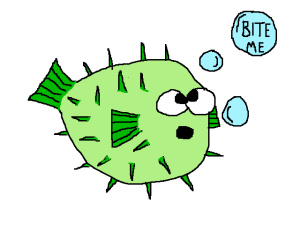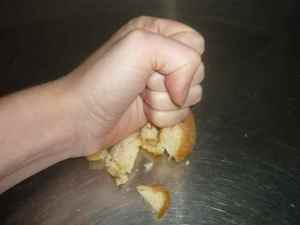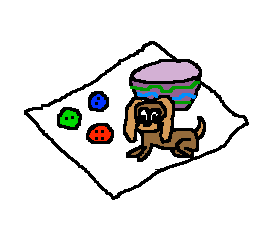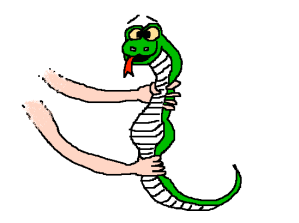These foods can be delicious, but they can also be deadly.
YOU ARE WHAT YOU EAT (THE MOVIE)
Making the human body from FOOD
Music: “The Annual New England Xylophone Symposium” by DoKashiteru (feat. spinning merkaba)
http://ccmixter.org/files/DoKashiteru/19848
is licensed under a Creative Commons license:
http://creativecommons.org/licenses/by-nc/3.0/
JELLY NINJA – THE DONUT MISSION
My attempt to demonstrate that 13 pieces can be produced from just 3 straight cuts to a donut (or donut-shaped food item such as jelly).
Donut challenge
Grab yourself a bag of donuts and settle in, because this is going to be a tasty and tricky experiment.
Here is your challenge: what is the largest number of pieces you can get from making 3 cuts in a donut? (Don’t run off and search this or you will find answers but you will lose the joy of boggling your mind and consuming your failed experiments)
Here are the rules: 1. Each cut must be made as a single straight line
2. The donut cannot be rearranged before the next cut, it must remain in a donut shape (such that if you were cutting with lasers rather than a kitchen knife, all 3 cuts could be made simultaneously)
3. If you are using a theoretical donut, assume that it is a 3-dimensional torus, with or without sprinkles
Please do comment to share your results. Solution has been posted above.
Hint: it’s more than 10 pieces
Raise your glass for Chemistry! (then drink it)
Video A toast to the Chemistry of Champagne – From Bytesize Science
Pasteurised then plasticised: how to make plastic from milk
Need to make buttons? A bowl? A sculpture of your dog?
Do you have nothing on hand except a bottle of milk and the following equipment?
Then this experiment is for you!
It will show you how to make plastic from the proteins in milk, then your creativity is only limited by your imagination and artistic prowess!
Qucik Bites
TRUE OR FALSE?
Australian scientists invented a beer specifically designed to be consumed in space.
True. It may not seem like the most productive use of our brightest minds or government funds, but scientists from Saber Astronautics have been working on producing the perfect beer for space tourists. In collaboration with Sydney’s 4 Pines Brewery, the scientists were working to optimise the taste of the beer and the carbonation, which are affected by zero gravity. Using a 23 metre high ‘drop tower’ the beer experiences about 2 seconds at zero gravity, allowing the scientists to examine changes in its properties. They were able to tinker with the recipe then pass it on to the Brewery to improve the taste. The beer was taste-tested in February 2011 on a microgravity flight in Florida and given approval by a microgravity expert.
Celery causes you to burn more calories than you consume.
Unconfirmed. Celery is made up primarily of water and cellulose, a plant carbohydrate which mostly passes undigested through the human digestive tract. Celery contains very few calories, and the body will expend a certain amount of energy (or number of calories) on digesting it. However, it is very hard to measure this input:output ratio to determine whether more calories are required in digestion than consumed in the celery. Our bodies require approximately 60 calories per hour while sleeping and 85 per hour while eating. 600 grams of celery (10 stalks) would provide about 85 calories, and if you really worked at it you might manage to get through them all in one hour. In this case, without any other energy expenditure, your calorie intake and output should be about equal. However, most people probably wouldn’t get through that much celery in an hour, so would be operating on an energy deficit, though a very small one.
Overall, it seems that digestion of foods such as celery, chinese cabbage, cucumber and lettuce may require more energy than is gained from the food, but the difference is small. The biggest effect on weight loss is that a mouth full of celery can’t be getting busy with a chocolate bar.
Asparagus makes your pee smell unpleasant.
True. For some people at least. During digestion our food gets broken down into lots of different chemicals. One of the chemicals which can be produced from digesting asparagus is mercaptan, a chemical compound which contains sulfur and is described as smelling of ‘rotten cabbage’. It seems that the ability to produce mercaptan (and smelly asparagus pee) is possessed by some people, but not others, and depends on your genetic sequence. But just because you can produce it doesn’t mean you can smell it. Some people cannot detect the distinctive aroma of asparagus pee even if they are producing it. The actual percentages of producers and smellers of asparagus pee are unclear as the many studies have produced many different results. If you want to test it yourself, you won’t need much equipment, and the odour should be present just 15-30 minutes after eating asparagus. If you’re looking for a bigger sample size though, you may have to hold a dinner party with some very open-minded friends.
Baking soda vs red wine
During the weekend I caught up with a few friends over a glass of wine. One of those glasses was of red wine and it happened to end up spilling onto the cream-coloured carpet. We did not see this as a wholly unpleasant occurrence (it wasn’t my house) but as a chance to conduct an experiment. Here I shall detail our approach and present you with the findings.






